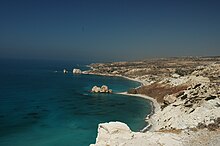Petra tou Romiou
34°39′49″N 32°37′37″E / 34.663517°N 32.62697°E


Petra tou Romiou (Greek: Πέτρα του Ρωμιού; lit. "Rock of the Roman", that is Eastern Roman or Byzantine,[2] or "Rock of the Greek"), also known as Aphrodite's Rock,[3] is a sea stack in Paphos, Cyprus. It is located off the shore along the main road from Paphos to Limassol. The combination of the beauty of the area and its status in mythology as the birthplace of Aphrodite makes it a popular tourist location.[4]
The sea in this region is generally rough, persuading tourists not to swim there. It is not permitted to climb the rock. A restaurant, a tourist pavilion and the Aphrodite Hills resort are nearby.

Legends
According to one legend, this rock is the site of the birth of the goddess Aphrodite, perhaps owing to the foaming waters around the rock fragments, and for this reason it is known as Aphrodite's Rock.[3] Gaia (Mother Earth) asked one of her sons, Cronus, to mutilate his father, Uranus (Sky). Cronus cut off Uranus' testicles and threw them into the sea. According to Hesiod's Theogony, Aphrodite was born out of the foam caused by Uranus' genitals as they were thrown into the sea.[6]
Similarly, the local version indicates that Aphrodite’s Rock is a part of the lower body of Uranus. This legend says that Cronus ambushed his father[7] and cut him below the waist with a scythe. Uranus, as he tried to escape flying, lost parts of his truncated body and testicles into the sea. A white foam appeared from which a maiden arose, the waves first taking her to Kythera and then bringing her to Cyprus. The maiden, named Aphrodite, went to the assembly of gods from Cyprus. The Romans widely referred to her as Venus. Aphrodite attracted a large cult following in Paphos, which was eventually crushed by the Romans.[8] This is evident from the Sanctuary of Aphrodite in Old Paphos, Kouklia. A local myth is that any person who swims around the Aphrodite Rock will be blessed with eternal beauty.
Another legend associates the name Achni with the nearby beach, and attributes this to it being a site where the Achaeans came ashore on their return from Troy.[4]
The present name Petra tou Romiou ("Rock of the Greek") associates the place with the exploits of the hero Basil as told in the Digenes Akritas. Basil was half-Byzantine (East Roman or Romios) and half-Arabic,[1] hence the name Digenes (two-blood). Legend tells that the Christian Basil hurled a huge rock from the Troodos Mountains to keep off the invading Saracens.[9] A nearby rock is similarly known as the Saracen Rock.
See also
References
- ^ a b Deligatos, Virginia A. (2008). The worldview of women in demotic historic, akritic and epic poetry of the late Byzantine Period (9th century to 1453) (PDF) (MA thesis). University of Johannesburg. Archived from the original (PDF) on 12 December 2013. Retrieved 19 September 2013.
- ^ Greeks after AD 212 referred to themselves as Ῥωμαῖοι (Romaioi) or Ῥωμιοί (Romioi), i.e. Romans, since virtually all Greeks were Roman citizens.[1]
- ^ a b "The Story of Aphrodite's Rock" (PDF). The University of Arizona Center for Middle Eastern Studies. Retrieved 19 September 2013.
- ^ a b "Petra tou romiou". www.thanasistavern.com/. Thanasis Tavern at Kouklia. Archived from the original on 12 December 2013. Retrieved 19 September 2013.
- ^ Ames-Lewis 2000, p. 194.
- ^ Cyrino, Monica S. (2012-06-25). Aphrodite. Routledge. pp. 13–14. ISBN 978-1-136-61591-7.
- ^ http://www.sacred-texts.com/cla/hesiod/theogony.htm | put in his hands a jagged sickle, and revealed to him the whole plot.
- ^ "Ashmolean Museum: Presentations - Ancient Cyprus - Aphrodite 2". 2006-05-11. Archived from the original on 2006-05-11. Retrieved 2023-10-01.
- ^ "Paphos Aphrodite Rock". www.paphos26.com/. Paphos26. 2006. Archived from the original on 6 June 2013. Retrieved 19 September 2013.
Works cited
- Ames-Lewis, Francis (2000), The Intellectual Life of the Early Renaissance Artist, New Haven, Connecticut: Yale University Press, ISBN 0-300-09295-4


